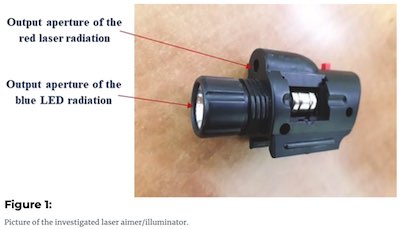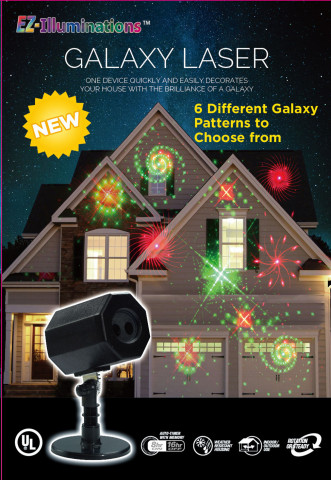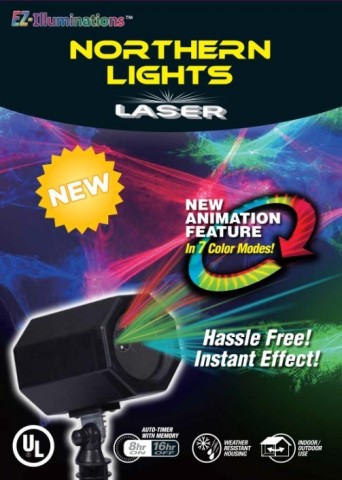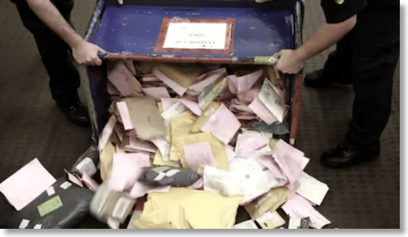Home
A comprehensive resource for safe and responsible laser use
Poland: Scientific paper says laser toy is misclassified, 4x legally required power

The paper examined the red laser's output and found it was 1.7 milliwatts. This is four times the Class 1 limit of <0.39 mW, and is 1.7 times the Class 2 limit of <1 mW. The laser should have been classified as Class 3R (<5 mW limit).
The author notes that according to the European standard EN 62115:2020, and guidance from Public Health England, laser toys should be Class 1. At four times the Class 1 limit, this toy's "radiation may be hazardous, especially when looking into the beam for long periods."
From Mlynczak, Jaroslaw. "Laser toys fail to comply with safety standards – case study based on laser product classification" Advanced Optical Technologies , no. (2021). https://doi.org/10.1515/aot-2020-0072
COMMENTARY FROM LASERPOINTERSAFETY.COM
We do not dispute Mlynczak's technical findings. However, there are some misleading or false statements in the paper that we would like to address.
- An erroneous title; it should be "Laser toy fails to comply…" The case study is not about "toys" plural. It covers only one sample of one toy rifle which had a laser aiming device that was found to be misclassified.
- Stating that the toy laser's output power (1.7 mW) is illegal, when it may have been legal or close to legal (within 0.7 mW) at time of sale.
- Calling the laser's light output "radiation" 14 times and never using the more precise term "light," thus giving a misleading impression the hazard might be similar to that of X-radiation or nuclear radiation.
- Stating without any proof or reference that children "will usually try to look directly into the laser beam."
- Stating without any proof or reference that children "could have temporary disturbances of vision… lead[ing] to a tragedy."
- Stating without any proof or reference that there is such a thing as "hypersensitivity to laser radiation."
- Stating without any proof or reference that "the described laser toy… [is] easily available and [is] still sold as toys in many European states."
- Listing in the References studies claiming laser "toy" injuries, which actually were from standard, non-toy laser pointers.
Details are below:Click to read more...
US: Nationwide recall of Santajoy Christmas laser lights sold at Walmart
On Dec. 22, 2017, Santajoy initiated a nationwide recall of Galaxy Holiday Laser Lights and Northern Lights Holiday Laser Lights. These laser projection products may incorporate a laser having a higher output than intended and fail to comply with FDA performance standard requirements (21 CFR 1040.10 and 1040.11). These higher-power lasers have the potential for eye injury.
Consumers who purchased any of the 5,254 units of Galaxy Holiday Laser Lights and Northern Lights Holiday Laser Lights sold by Walmart between August 1, 2017 and October 25, 2017 should stop using them and return them to any Walmart store for a full refund.
The Galaxy Holiday Laser Lights and Northern Lights Holiday Laser Lights were manufactured from May through September 2017 and distributed from August through October 2017. The affected products sold by Walmart can be identified by the packaging photos and UPC numbers shown below.
Santajoy voluntarily recalled these products after becoming aware that the product presented a potential safety hazard and has notified the FDA of this action. There have been no reports of injury related to the use of these products. Santajoy is notifying the public through this press release, and Walmart is accepting the return of these products for a full refund.
Walmart Stores Inc. distributed these products nationwide. Consumers with questions may contact Walmart via telephone at 1-800-Walmart from 7 a.m. to 9 p.m. CT Monday through Friday or online at www.corporate.walmart.com/recalls for more information.


Note: As of January 1 2018, neither laser was listed on the Walmart Product Recalls webpage. The product recall also did not appear to be at FDA’s recalls webpage or enforcement report webpage, as of January 1. The only online source on that date was the December 22 2017 Business Wire press release, or a few publications and news sources such as KCTV that reprinted the Business Wire press release.
Australia: Study shows inexpensive green laser pointers are mislabled and significantly over-powered
The researchers purchased eight laser pointers from sources including electronics stores and online stores. They bought four lasers with green beams and four with red beams. The cost of each laser was less than AUD $30 (USD $23).
All of the lasers were advertised to have a maximum output power of either less than 1 mW or less than 5 mW. The green laser pointers’ actual output power measured from 51 to 127 milliwatts. Dr. Fox said “At that upper level, the beam would cause catastrophic retinal damage.”
Apparently much of the green lasers’ power was in the infrared. These types of lasers work by generating non-visible infrared light which is then converted by a crystal into visible green light. A filter is normally used to block the infrared light, and only let the green light through. However, “[t]he research team found that imported laser pointers were poorly made, with manufacturers tempted to skip installing infrared-blocking filters to hold down costs.” The researchers did not measure how much of each lasers’ output was in the visible, and how much was in the infrared.
The 127 milliwatt green laser was labeled as a Class 2 device, with maximum output power of 1 mW. In a previous study from the U.S. NIST, the highest power output they measured was 66.5 mW from a green laser labeled as having a maximum output power of 5 mW.
Three of the four red laser pointers were found to be within the legal limit of 1 milliwatt. The fourth red pointer was about 8.5 milliwatts. The researchers felt that the red lasers’ spots were less focused than green lasers, meaning there was less risk of retinal damage. Also, red lasers use diodes. The maximum power output of these diodes is limited; excessive current will destroy the diode’s lasing capacity instead of providing a more powerful beam.
The researchers noted that “Our experiment raised two very pertinent concerns – first, why were class 3B lasers so easily purchased via the internet without licensing? This suggests that there are many loopholes in the importation of these products and more stringent processes need to be reinforced. Secondly, why did green lasers labeled as Class 2 reach up to a power output of 127mW, effectively attaining a class 3B classification? It is very likely that there is a significant infrared component. This drastic degree of non-compliance suggests that there needs to be more rigorous testing and quality control of these commercially available lasers – merely imposing a power limit of less than 1mW is insufficient.”
The researchers concluded by stating that “Authorities such as the Australian Radiation Protection and Nuclear Safety Agency (ARPANSA) and medical authorities such as the Royal Australian and New Zealand College of Ophthalmologists (RANZCO) ought to advocate more strongly for stringent testing, quality control and licensing of green DPSS lasers.”
From an RMIT press release, “Over-the-counter laser pointers a threat to eyesight” and an advance copy of a paper, “Green lasers are beyond power limits mandated by safety standards,” which will be published in the Proceedings of the 2016 IEEE Engineers in Medicine and Biology Conference, online at the IEEE Xplore website. Thanks to Dr. Kate Fox for the paper.
UK: Seizure of 7,000+ laser pointers illustrates control problems
7,378 lasers were seized, along with 8,780 parts from which lasers could be assembled. It was estimated that the company sold over 35,000 laser pointers from 2009-2011, generating income of over £1,000,000 (USD $1,600,000).
Techyun Hii, 33, pleaded guilty to four charges of laser pointer violations and a fifth charge of unsafe power chargers. He was sentenced to a 180 day jail term suspended for 18 months, and to 300 hours of community service. The lasers were later incinerated in a hospital’s furnace.
Lead author John O’Hagan detailed the HPA’s findings in a paper presented at the March 2013 International Laser Safety Conference in Orlando. The case had previously been reported by LaserPointerSafety.com.
Click to read more...
US: Government agency finds most laser pointers they purchased are overpowered
The findings were made public at a March 20 2013 meeting of the International Laser Safety Conference.
Researcher Joshua Hadler designed the measurement device to be accurate, inexpensive and easy-to-use. It would cost roughly $2000 in equipment costs to make a copy of the NIST device; plans are available from NIST for interested parties.
From a NIST press release, March 20 2013.
Click here for the full press release:Click to read more...
Australia: Ban on laser pointers has been a "detriment" to safety
The author, Trevor Wheatley, is chair of the Standards Australia SF-019 Committee on laser safety. He studied 41 lasers purchased online in 2012 that were claimed by the sellers to be legal -- lower than the Australian import limit of 1 milliwatt. Most cost less than AUS $20.
Wheatley found that 95% of these pointers were illegal under Australian law, with outputs above 1 mW. Of the 41, 78% were between 5 mW and 100 mW. (5 mW is generally taken to be the highest safe power for a general purpose laser pointer.)
Based on Wheatley's research, "...there would appear to be a greater than 50% chance that someone attempting to buy a 'safe' laser pointer would inadvertently get a hazardous laser." Further, 100% of the tested laser pointers below $20 "would represent prohibited weapons in most Australian states."
From other statistics, the paper states that "availability has not been significantly impacted." In 2007/2008 there were 648 incidents involving lasers pointed at aircraft. In 2010/2011, well after the import and possession restrictions, the number of incidents had increased to 828.
Click to read more...
Australia: Illegal laser imports up 60%; threaten aircraft safety
Illegal imports of laser pointers explode - 24 July 2012
Customs and Border Protection is warning travellers and online shoppers about Australia’s tough laws prohibiting the import of laser pointers.
This follows a dramatic increase in the number of these dangerous items being seized by officers at the border.
In the past year, the number of laser pointers seized by Customs and Border Protection officers at the Sydney International Mail Centre alone has increased by close to 60 per cent, from around 9,000 to over 14,000.

Australian import officers spill out a container full of confiscated packages of illegally-imported laser pointers.
Importing laser pointers greater than one milliwatt in intensity is prohibited in Australia without a permit.
“The sheer volume of these importations suggests that people do not understand the threat these items pose to safety, particularly to commercial aircraft,” said National Manager Cargo Operations, Jagtej Singh.
Customs and Border Protection officers are trained to detect prohibited and restricted items from the millions of items which arrive each week.
“If you try and import laser pointers without a permit, there’s a high possibility they’ll be found by Customs and Border Protection, seized, and you may even face fines of up to $275,000.”
Customs and Border Protection has produced a video clip outlining the risks being taken by people who inadvertently or deliberately breach the laws on laser pointers.
It can be viewed on the agency’s YouTube channel.
According to this video, “Customs officers screen all incoming mail imported into Australia, and items such as laser pointers WILL show up on X-ray.”
Media enquiries: Customs and Border Protection Media (02) 6275 6793
From Australia Customs and Border Protection
Switzerland: Laser pointer labels can understate their power
The Swiss government banned the sale of “powerful laser pointers” in May 2011. According to World Radio Switzerland, the country is considering a ban on owning such pointers.
From World Radio Switzerland